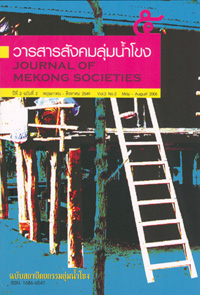Spirit House, Burial Pillar, Wooden Stupa, and the House Cover Stupa of the Tai Tradition in Mekong Basin
Main Article Content
Abstract
There are several Tai groups in the Mekong basin region. While Theravada Buddhism is the dominant religion, indigenous animistic influences have been preserved. Traditionally, the Tai performed cremations or burials in cemetery forests (pa cha). A spirit house (ruen phi) was built at the burial site. Another spirit house, known as ruen noi or small house (a wooden gable roof structure placed on single pillar or four pillars), was built to hold the ashes of the deceased. Apart from the spirit house and the small house, a burial pillar (lak se) was another way to mark a burial site. When the Buddhist practice of enshrining relics or ashes in a stupa was accepted by the Tais, the local traditional spirit house and burial pillar were influenced by the concept of the Buddhist stupa. The burial pillar was later developed into a form of wooden stupa (that mai). The most significant representation of this Buddhist concept is that this wooden stupa was moved from the cemetery forest to the Buddhist monastery. This wooden stupa usually has a square plan. This feature later became the traditional form of the Thai-Lao brick masonry stupa. Furthermore, some small houses enshrining ashes were also allocated into the area of Buddhist monasteries. Another integrated concept of the Buddhist stupa and the spirit house is a stupa covered by a house. Although this structure was found long ago in Sri Lanka, this simple gabled roof structure containing a stupa might be the representation of the concept of building a spirit house, rather than an influence from Sri Lankan Buddhism. This idea is supported by the fact that it is not found in the Theravada Buddhist states of Ayutthaya, Lanna, Cambodia, or Burma.


